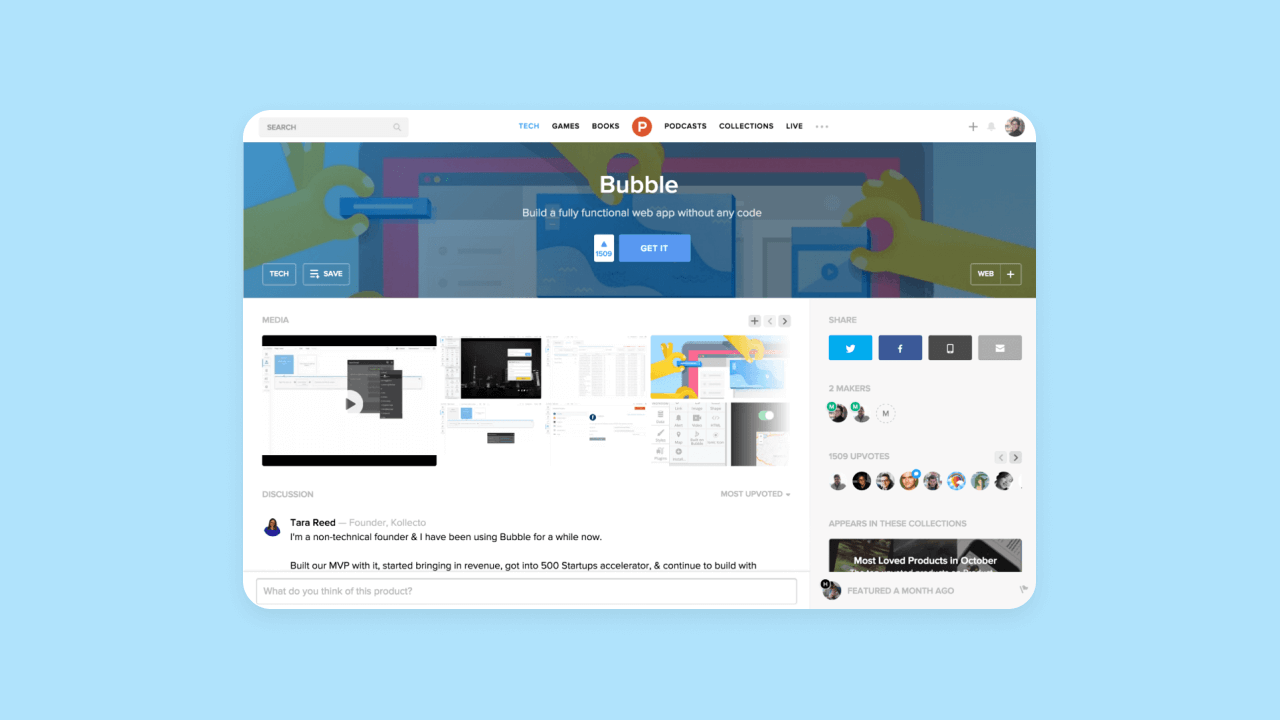We’ve been building Bubble — a platform that allows users to build applications visually, without code — for more than 3 years now. For a while, we avoided any sort of public launch. We knew that a lot of people would be skeptical. We knew that we had a lot to prove.
But after months of testing our technology in production with a few key clients, we felt ready to step out of the shadows. So earlier this month, we decided to launch on Product Hunt.
We were featured on October 5 and it went better than we could have hoped, ending the day at the top of the list with more than 800 votes. We also received more than 20,000 unique visitors that week and 3,000 new users started actively building apps on Bubble. The launch triggered a lot of shares, emails and manifestation of love that will be an incredible asset as we move forward.
By the end of the month, we were the second most upvoted product, with more than 1,500 votes!
Why We Chose Product Hunt
While we couldn’t have predicted becoming the most upvoted product of the day, we knew that if we were going to have a meaningful launch anywhere, then PH was our best shot. The community is filled with people who have great ideas and are interested in cutting-edge products; and we don’t only hope to make Bubble a great product — we also hope other people build great products with Bubble. We believe our platform can meet many of the community members’ needs quite well.
We applied late September to offer an exclusive deal to ProductHunters through the online form. I was put in touch with Ben Tossell from their team to talk about the specifics. Seeing as though we had already been featured in June 2014 while we were in beta (a user actually submitted Bubble then), we had to talk to the team to make this happen again.
The vote total was climbing pretty quickly, and by mid-afternoon we were behind only Google’s new search functionality that displayed animated GIFs. As soon as we took the number one spot, the momentum actually increased and we ended up with 800 votes at the end of the day. Amazingly enough, a month later, we’re beyond 1,500 and it’s been generating serious traffic since then.
We can’t thank ProductHunt and the community enough for the opportunity. One small way we can give back is to share what we’ve learned and offer some tips to having a successful experience on Product Hunt.
Tips & Takeaways
1) Get your users’ support. We emailed our community one hour after being featured and asked them to jump in and comment. One user (Tara Reed) posted this amazing comment/testimonial that ended being upvoted more than 50 times — way more than my initial introduction post! I have no doubt this helped a ton with converting visitors to our ProductHunt page into upvotes and actual signups. Products like Bubble need validation from users, especially at it requires some learning. Having a user genuinely explaining what she did with Bubble was a fantastic asset.
2) Be super reactive when people post questions. The faster you answer, the more likely you’ll turn a post into a conversation, which 1) will engage more people to interact 2) (I’m pretty sure) will move you up on the list, even if you have less votes than another featured product. In other words, you should be willing to spend a full day interacting with the community about your product — it’s well worth it.
3) Real traction comes later. We shared on social media that we were featured on ProductHunt as soon as we saw Bubble on the first page. Because we don’t have a strong social presence, that honestly didn’t generate much buzz. However, there is a tipping point when you get close to 500 votes. ProductHunt itself starts tweeting about you, and more people retweet. We saw a clear acceleration in the number of upvotes after that threshold.
4) Wait until you’re ready. A common way of thinking nowadays is, “if you’re not embarrassed when you launch, that means you waited too long.” Not sure how much I believe that one. We certainly believe in iteration and collecting feedback – but we felt that if we were going to actively push publicly, we wanted to feel confident about what we built. For us that meant not only having a robust platform, but also building out our documentation. I’m glad we waited; I’m certain the documentation and the lessons we now have helped a lot with conversion.
5) Take the visual aspect of your ProductHunt page seriously. We had an original illustration for the header and did a video, which got more than a thousand views in a day. Keep in mind this page, especially if you do it well, will always be there and will become one of the profile pages for your product.
6) Say thank you. If people are taking the time to check out your product and leave feedback — even if it’s not an overwhelmingly positive comment — make sure you respond and thank them. This not only includes the ProductHunt page itself, but also on social media (we also emailed some people directly who signed up for Bubble after upvoting). The amount of re-shares we got after thanking people was just amazing.
Good luck to everyone launching on Product Hunt! It’s been an incredible past couple of weeks, and we’re happy to say we’ve never been busier :) We hope you’ll have as much fun as we did — reach out if we can help!
Build for as long as you want on the Free plan. Only upgrade when you're ready to launch.
Join Bubble






